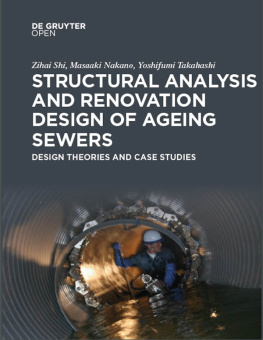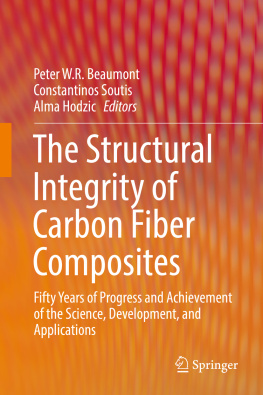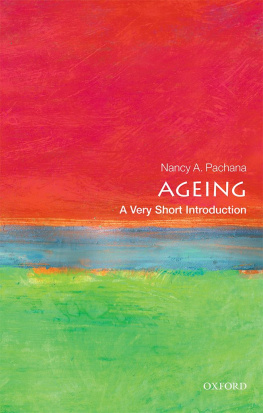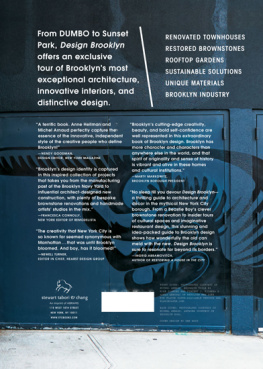Table of Contents
Pagebreaks of the print version

Zihai Shi, Masaaki Nakano, Yoshifumi Takahashi
Structural Analysis and Renovation Design of Ageing Sewers
Design Theories and Case Studies
ISBN 978-3-11-047173-1
e-ISBN (PDF) 978-3-11-047174-8
e-ISBN (EPUB) 978-3-11-047191-5

This work is licensed under the Creative Commons Attribution-NonCommercial-NoDerivs 3.0 License. For details go to http://creativecommons.org/licenses/by-nc-nd/3.0/.
2016 Zihai Shi, Masaaki Nakano, Yoshifumi Takahashi
Published by De Gruyter Open Ltd, Warsaw/Berlin
Part of Walter de Gruyter GmbH, Berlin/Boston
The book is published with open access at www.degruyter.com.
Library of Congress Cataloging-in-Publication Data
A CIP catalog record for this book has been applied for at the Library of Congress.
Managing Editor: Irmina Grzegorek
Language Editor: Adam Tod Leverton
www.degruyteropen.com
Cover illustration: provided by Sekisui Chemical Co., Ltd.
Complimentary copy, not for sale.
Contents
Author Information
Zihai Shi ( 1.1, 4, 5.1-5.3 )
Principal research scientist, Research & Development Centre, Nippon Koei Co., Ltd. Graduated from Civil Engineering Department, University of Tokyo in 1989. Doctor of Engineering.
Major: Fracture mechanics, mechanics of fatigue, structural engineering
Yoshifumi Takahashi ( 1.2-1.3, 2 )
Senior adviser, Tokyo Sewerage Service Co., Ltd.; former Director for Technology Development, Sewerage Bureau, Tokyo Metropolitan Government. Graduated from Civil Engineering Department, Nihon University in 1971. Doctor of Engineering.
Major: Sewerage Engineering, structural engineering
Yukari Nakamura ( 3, 7 )
Researcher, Research & Development Centre, Nippon Koei Co., Ltd. Graduated from Civil Engineering Department, Kagoshima University in 2008. Master of Engineering.
Major: Structural engineering
Jianhon Wang ( 5.4 )
Senior researcher, Research & Development Centre, Nippon Koei Co., Ltd. Graduated from Civil Engineering Department, Waseda University in 2009. Doctor of Engineering.
Major: Buckling of thin-walled structures, tunnel engineering
Masaaki Nakano ()
Senior researcher, Research & Development Centre, Nippon Koei Co., Ltd. Graduated from Science and Engineering Department (mathematics), Waseda University, Tokyo (B.S.) in1992; graduated from Environmental Science Department, Natural Resource, Carroll University, Wisconsin (B.S.) in 1994. Bachelor of Science.
Major: Fracture mechanics of concrete, structural engineering
Toru Kouchi ()
Researcher, Research & Development Centre, Nippon Koei Co., Ltd. Graduated from Civil Engineering Department, Tokyo City University in 2011. Master of Engineering.
Major: Structural engineering
Preface
This book presents a systematic treatment of fracture-mechanics based structural analysis and renovation design of ageing sewers as semi-composite pipes. These have been employed for sewer renovation in Japan, especially in the Tokyo metropolitan area for more than fifteen years, with the total length of renovation construction now exceeding 700 km. The concept of a semi-composite pipe and the application of fracture mechanics of concrete in numerical modelling of the structural behaviour of a renovated sewer pipe are the two distinctive features of the established design theories that have emerged and matured with the development of a sewer renovation construction method (the SPR method, which received the top industrial technology development award in Japan, the Oukochi Memorial Prize 2013).
The general practice of sewer renovation in Japan, from site survey and structural design to renovation, is subject to the Japan Sewage Works Associations Design and Construction Guidelines for Sewer Pipe Rehabilitation . The Guidelines apply to two types of renovation method, namely, the independent (or stand-alone) pipe method and the composite pipe method, with the former being used mainly for non-man-entry sewers with circular cross section and the latter for both man-entry and non-man-entry sewers with arbitrary cross sections. In the composite pipe construction approach, a liner pipe is constructed inside an existing sewer by interlocking strips of surface materials made of polyvinyl chloride or polythene resin, and the annular space behind the liner is filled with cementitious grout under pressure to form a highly integrated structure. The Guidelines define a composite pipe as a composite structure requiring complete integration between the renovation layer and the existing pipe.
Test results show that the bond strength of cementitious grout is typically half the tensile strength of normal concrete. With this limited bond strength, the requirement for a rigid connection between the existing pipe and the renovation layer in the composite pipe method may not always be guaranteed. To fully explore the advantages of the composite pipe method in sewer renovation while keeping safe design in mind, a semi-composite pipe structure has been proposed based on three assumptions for the interface: a perfect bond after construction, a no-tension interface (i.e., the interface does not bear tensile force) and a perfect bond under compression. The resulting structure resembles a composite structure with mechanical connectors set in the compression zones along the interface that are intercepted by no-tension interface zones with free surfaces, and thus is called a semi-composite pipe structure.
The design approach for this semi-composite structure is based on the theory of limit state design. As a typical feature of this design approach, nonlinear structural analysis including crack analysis is performed on a semi-composite pipe under extreme load conditions to obtain its characteristic load-carrying capacity. The details of the renovation layer including the thickness and ratio of steel reinforcement are then determined using design formulas based on the ratio of member force to member strength with relevant safety factors considered. Next, a seismic performance evaluation is carried out to ensure the renovated pipe meets the code requirements for earthquake resistance.
The leading authors of this book have been involved in designing the renovation of ageing sewers since the mid 1990s, and the design theories and design practices introduced here are the crystallisation of their collaborative research efforts, which have been greatly strengthened by their younger colleagues who have joined the team in the past five or six years. The book contains eight chapters. on design case studies.
The book was written as a reference work focusing on the latest technical developments in sewer renovation in Japan for both sewer engineers worldwide and students of civil and urban engineering. The authors are both researchers and practicing engineers with extensive experience in the renovation design of ageing sewers. Each chapter was written by one or two co-authors, and was edited for content, accuracy and style.
Just like an artist in painting or music, I sometimes feel that our daily engineering work such as the issues discussed in this book is as creative as the traditional arts that we enjoy for their beauty or emotional power. This may sound farfetched, but when you face a new project for which you are aware of only some of the mechanics principles required, you really need to rely on your engineering instinct, creative skill and imagination to identify the best approach. Our work may not be enjoyed for its beauty (normally you cannot even see the sewer), but its emotional power may be associated with the safe infrastructure of a modern society, of which a sewerage system is a vital component. If the readers of this book even partially agree with me, this will mean, at least for me, mission accomplished.











